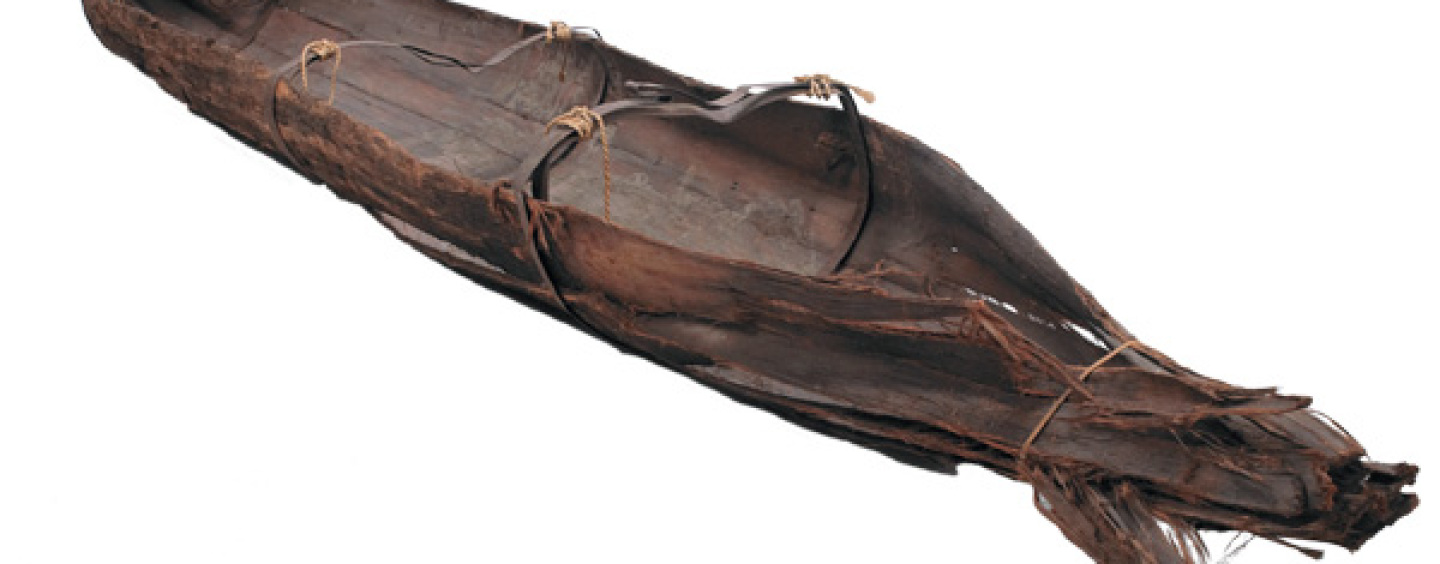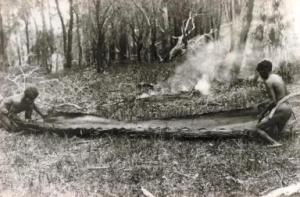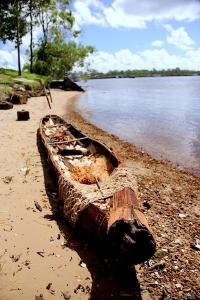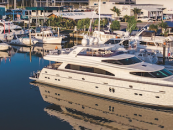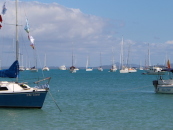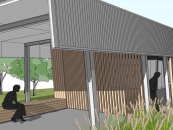Ever popped into your dinghy and wondered how long others have done similar? Dr Ray Kerkhove shares his studies on Aboriginal watercrafts and boating more than thousands of years ago.
For thousands of years, Aboriginals travelled up and down the Gold Coast’s rivers and coasts, and into Moreton Bay: island-hopping, fishing, turtle-hunting, raiding, trading, transporting, or simply visiting friends and relatives. Many current waterways were learned from Aboriginal people.
Waterway world
One of the first things explorers Flinders and Oxley noticed here was people in canoes—fishing, setting weirs and hand-nets. Pioneers witnessed scores to hundreds of canoes filling the lakes for night fishing, or crossing the Bay to bury elders.
The canoe was so important that it featured (as a sand effigy) at bora grounds. There was a major Dreaming story known from northern New South Wales into Southeast Queensland concerning Three Brothers coming across the sea in a canoe, landing at various places to create landscape or found tribes.
South-east Queensland has many creeks, rivers and lakes. These were often the quickest way to get around. It was not uncommon for Aboriginals to travel three to six kilometres by water. Sometimes, trips were made between Woorim (Bribie Island) and Bulwer (Moreton Island)–16 kilometres of open water!
In many places, bark canoe, much like ferries, were placed on both sides of a river, so that travellers could cross when they needed.
Variety of water craft
Few pioneers bothered to sketch Aboriginal watercraft. We rely more on what was written. We know there were both rafts and canoes. Rafts were small—dry sticks bound together with bark string and covered with sheets of tea-tree bark. There was also a bark sheet raft, tied at each end, used on rivers.
More common were single-sheet bark canoes, called kundul/condol. These have ends folded concertina-style. They varied in size. Women had small craft for scurrying around the mangroves and river islands to collect shellfish and crabs without having to step into the muck. For crossing the Bay or for turtle and dugong hunts, large, stronger types were required, as they had to freight turtles and 10-kilogram millstones, drag dugongs and transport up to 10 passengers. Some of these were 30-40 feet long (9-12 metres).
Building a canoe
From research, it was learned that hulls were usually Swamp Mahogany or Swamp Box bark. Another favourite was stringy bark. Finding a tree big enough to use, let alone one the Aboriginals could get permission to use, was a huge challenge.
Traditional bark-removal scars, but never kills a tree. A rectangular slab is removed leaving a small piece around the back. This grows back, giving the classic oval-shaped “canoe scar.” Very old scars close into a single slit.
Ideally, the slab should be shaped when fresh off the tree. It is moulded with the heat of a fire, but this (and removing the bark) is a long process. Avoiding warping or splitting the bark requires much attention.
Supplejack or lawyer cane was the traditional twine for tying canoe ends. To strengthen the inside of the gunwales, lengths of wattle or burney vine are looped through holes to bind them in place. In larger canoes, interior “ribs” additionally strengthen the hull.
Thwarts are supplejack or lawyer cane twisted like rope, sometimes around sticks. These are tied with a hole and loop on either side of the gunwale. There might be two or three depending on the size of the vessel. This of course helps keep the hull spread. Sealant, especially for the stern and bow, is grass tree gum, hoop or spotty gum resin.
Each vessel carries the following: a three-metre long, thick stick to paddle, push and steer; shaped pieces of bark (for the same purpose); an “emergency kit” of a ball of white clay and a bailer shell; ti-tree bark (seating); and a pile of dirt and clay on which a firestick can rest. The fire is a combination torch, heater and fishing lure.
By the 1840s-1870s, many Aboriginals worked as boat pilots, crews, ferrymen and fishermen for the Europeans. This is how bark canoe-making slowly died out.
*In 2013, I assisted the research for Gubbi Gubbi Gun’doo Yang’ga’man (“constructing Gubbi Gubbi canoes”) for Sunshine Coast Regional Council. This was with a team of Indigenous knowledge-holders: Lyndon Davis, Brent Miller, Kerry Jones and others. The end result saw a trial run at the ‘Floating Land’ festival (Noosa). One canoe is still touring Australian galleries and museums.
The work took painfully long: much research and trial and error. Although in the old days, canoe-builders could assemble a vessel overnight, we took months! The team found the season had to be just right (e.g. when the sap was running up the bark) and might involve a whole clan travelling to a selected tree and staying there.
**Dr Ray Kerkhove is an independent historian and cultural researcher who has worked a number of decades with Indigenous groups. His speciality is the Indigenous history and material culture of southern Queensland. He conducted his research from 2011 to 2013, and presented his papers at various conferences.
Aboriginal pilots and regattas
The first regattas in southern Queensland (held near Newstead) were all won by Aboriginal teams. The very first in 1848 was entered by Aboriginal boatmen from Stradbroke Island. They had been gifted a whaleboat for saving victims of the Sovereign shipwreck. They named their whaleboat “Pirate” and sported a pirate flag! Eventually separate races had to be created for Aboriginal rowers, as the Europeans were always defeated, but sadly the Aboriginal contest died quickly as European patrons had more interest in their own competitors.
The castaways
The castaways Finnegan, Pamphlett and Parsons relied on Aboriginal canoes a lot to travel around the district. The castaways grew so accustomed to finding them at crossing points that they were annoyed when there were none near the mouth of the Brisbane River. They even grew ungrateful, stealing one big canoe full of fish when they found it unattended near a camp at Clontarf. The owners spotted them and gave chase, following the trio in another canoe across Hayes Inlet, but nevertheless housing and feeding the would-be thieves.






















